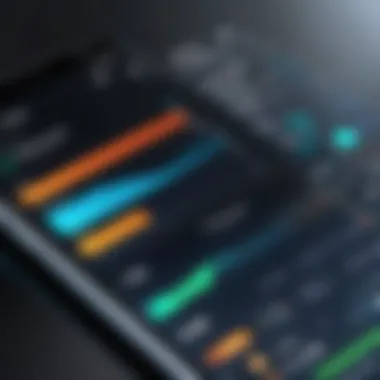Identifying a Blocked Number: A Comprehensive Guide


Intro
Everyone has those nagging suspicions that someone may have blocked their number. Perhaps it’s that friend who suddenly stopped responding, or a loved one who seems to have vanished from the digital realm. Understanding the signs that hint whether you've been blocked is no small feat, especially in an age where communication is largely digital.
In this article, we’ll untangle the web of clues and indicators that could suggest your number has been blocked. From technical insights to real-life scenarios, we aim to guide you through the process of identifying potential communication barriers. Whether you're a tech-savvy individual or just a curious user, our guide will equip you with the necessary knowledge to discern the truth behind the silence.
Understanding Call Blocking
In an era where connectivity is paramount, the ability to control who can reach you has become increasingly significant. Understanding call blocking isn't just about the mechanics; it taps into our need for privacy and the management of personal relationships. For many, a simple blocked number can stir a mix of emotions and perceptions about trust and respect. This article aims to lay bare the intricacies involved in identifying whether a number has been blocked.
Being equipped with this knowledge ensures you can address your communication methods proactively. You might wonder if you're on receiving end of a blocked call, and it’s essential to navigate this delicate territory with care and clarity. Whether you’re avoiding persistent callers or simply managing your contact list, understanding call blocking can help you maintain your peace of mind.
Definition of Call Blocking
Call blocking is essentially a feature offered by most telecommunications service providers and phone manufacturers to restrict incoming calls from specific numbers. When you block a number, any call from that number either goes directly to voicemail or is entirely rejected. This function serves as a boundary, allowing individuals to take control over their phone etiquette and personal space without the drama of confrontational conversations.
Most smartphones today come equipped with easy-to-use call blocking features, making it more accessible than ever for anyone feeling overwhelmed by constant interruptions. It may seem like just a click of a button, but the implications of being blocked can stir different sentiments—curiosity, concern, or even anger.
Reasons for Blocking Numbers
There are myriad reasons as to why one might choose to block another's number, and these can often be deeply personal. Some common motives include:
- Harassment: Persistent and unwanted calls, especially from telemarketers or stalkers, can lead anyone to reach for the block button.
- Privacy: Keeping one's personal space intact is vital. People frequently block numbers to prevent unsolicited communication from acquaintances or strangers.
- Miscommunication: Sometimes relationships change, and what was once a friendly line of contact may evolve into a necessity to block in order to avoid further misunderstandings.
- Emotional Well-being: If a contact is a source of stress or negativity, blocking may be a means to protect one's mental health.
Understanding these reasons can help contextualize the emotional weight behind the act of blocking, increasing empathy toward those whose numbers may be redirected into the abyss of digital silence.
Common Symptoms of a Blocked Number
Determining if someone has blocked your number isn't always straightforward. However, recognizing the common symptoms can provide valuable clues. Each symptom can serve as a piece of the puzzle. When put together, they may give insight into the dynamics of your communication with that person. This section will delve into the specific signs to be aware of, helping you piece together the reality of your situation.
The Silence After Calling
Have you ever experienced a disconcerting silence after dialing a certain number? After repeated attempts to reach a contact, you might notice a peculiar absence of response. When you call a number and there’s no ring tone or a standard voicemail greeting, it can be quite telling. This silence can be more than just a fleeting oddity. It can signal that your calls aren't getting through as expected.
In some cases, the phone may ring once and then cut off entirely. This behavior could indicate that the number is blocked. Keep in mind, though, that network issues or the receiver having their phone off can also produce similar results. So, while silence is a critical sign, it’s not definitive on its own.
Feeling of Detachment in Messages
When you send a text and receive no response, it might feel like you’re shouting into the void. A sudden lack of replies can evoke a haunting feeling of disconnection. When you text someone and the messages remain unread, this could be another red flag. For instance, if the typical two blue checkmarks in WhatsApp turn into just one gray checkmark consistently, it might suggest that the recipient has chosen not to engage with your messages. This shift can be hard to swallow, particularly if prior communications were frequent and fluid.
Messaging platforms may also have unique features that indicate privacy levels. If the contact usually replies quickly but suddenly goes silent, that might speak volumes. Of course, people get busy; however, it pays to be vigilant about such shifts in interaction. A stark change can hint at deeper issues at play, such as a blocking scenario.
Unexpected Voicemail Behavior
Voicemail can also provide distinct clues. If a number you're trying to reach takes you directly to voicemail after just one ring or no rings at all, there’s a fair chance that the calls are being diverted. You might find yourself recording the same message repeatedly, wondering if anyone hears it.
Moreover, if your messages are consistently met with an automatic response or you’re getting bizarre voicemail greetings that feel out of character for that contact, it could indicate that you’re not exactly on their list of priorities. For example, some carriers provide specific voicemail setups for blocked numbers. This means that your attempts to reach out could vanish in the ether while their phone stays silent.


"A change in the way you communicate can sometimes speak louder than the words themselves."
Thus, these behavioral changes in voicemails not only serve as potential indicators of being blocked but also as significant symbols of the relational shift that may have occurred. By paying close attention to these signs, you can better understand the current state of your communication and relationship.
Technical Indicators of Being Blocked
Understanding the technical indicators that suggest your number may be blocked is crucial in the modern landscape of digital communication. With the rise of smartphones and constant connectivity, discerning whether messages are reaching their intended recipients can often be a matter of emotional and practical consequences. By familiarizing yourself with the technical signs, you can navigate these troubled waters more effectively, whether you're looking to repair a strained relationship or simply satisfy your curiosity about a friend’s sudden unavailability.
Differences in Call Notifications
When you try to call a contact who may have blocked you, you’ll likely notice discrepancies in how your phone logs the call. Typically, if you get blocked, the most immediate difference you might see involves call notifications.
Generally, when you place a call to someone and it rings, it means the call is reaching their phone. However, if the phone jumps straight to voicemail or rings only once before cutting off, those could be key signs of a block. Sometimes, you'll see a notification that's unusually quick—ringing for just a moment before silence hits the line.
It's worth noting that network issues can produce similar symptoms. So, don’t jump to conclusions right away. Waiting a bit and trying again could help clarify the situation. If you consistently experience these unusual notifications over multiple attempts, then you could be looking at an indicator of being blocked.
Changes in Message Status
Another telltale sign comes from your text messages. Users often rely on delivery reports or status indicators to gauge whether their messages have been received. For example, on apps like WhatsApp or iMessage, you typically see one tick mark or one gray status bar for a sent message, and two ticks or a double blue check mark when it is delivered.
However, if you notice your messages displaying only one tick indefinitely, you might be facing a blocking scenario rather than a standard technical glitch. In some cases, if your texts go through but the intended recipient isn't responding, they might have muted notifications instead. Here, context is critical. If it’s someone you usually chat with, a sudden halt in responses can seem awfully suspicious.
Analyzing Call Logs
Keeping track of your call history also serves as a vital tool in this investigation. Take a close look at your recent call logs. If you find repeated entries that show a call to your contact but lack any associated status—like “missed” or “answered”—it might suggest your number has been blocked.
These call logs often reveal patterns or serve as subtle clues to a bigger picture. If a contact who once engaged regularly with your calls now shows an empty status, it could raise an eyebrow. Additionally, double-checking whether their number is still saved correctly in your contacts can sometimes yield surprises; people often change numbers without informing others.
Remember, these indicators can improve your overall understanding of blocked communication scenarios. When you recognize these signs, you gain leverage in deciding what steps to take next. Whether you’re a tech-savvy individual or just someone navigating the challenges of modern communication, identifying these indicators is vital in maintaining clarity and purpose in your interactions.
Experimenting with Alternative Contact Methods
When you feel the weight of digital silence hanging in the air, and those texts go unanswered or calls met with a deafening stillness, it is time to think outside the box. Experimenting with alternative contact methods is a practical way to determine whether you’ve hit a wall with your communication efforts. In this section, we’ll delve into the nuances of utilizing different channels to make contact, the potential benefits of doing so, and some considerations to keep in mind. The key here is proactive engagement.
Using a Different Number
Switching gears and trying a different number might seem a bit unorthodox, but it can be a useful tactic. Here’s the scoop: using another phone, whether it’s a landline, a friend’s mobile, or even a temporary number from apps like Google Voice, can provide fresh opportunities for reaching out.
- Why Bother?
- Considerations:
- The primary goal is clarity. When you reach out from a different number, you can gauge the likelihood of being blocked based on the response (or lack thereof) to this new contact. It sidesteps any preconceived issues tied to your original number.
- Ensure that you are not infringing on privacy or escalating the situation. Even innocent intentions can be misconstrued. Keeping your touch light and respectful is crucial here.
- Be mindful that repeated calls from unrecognized numbers may irritate the person you are trying to reach. It's a delicate dance.
Reaching Out via Social Media
In the age of social networking, social media presents an almost automatic route to reconnect. Many of us live in a digital world where reaching out via social media can break the ice far faster than a phone call.


- Platform Choices:
- Pro Tips:
- Potential Pitfalls:
- Think of Facebook, Twitter, or Instagram. Each platform can have its nuances regarding messaging style.
- Direct messaging (DM) can enhance the chances of getting a response. For someone barred from conventional text messages, this can be a golden key.
- Approach the conversation casually at first. Directly mentioning the blocked number might come off as confrontational. Start with a general inquiry about their wellbeing or recent activities. A laid-back style often yields better outcomes.
- Be cautious about crossing boundaries. If someone has blocked you for a reason, forcing your way onto their social media might increase tension instead of easing it.
"Navigating alternate avenues of connection can clarify communication status without causing unnecessary drama."
Experimenting with different contact methods is essential when navigating the murky waters of potential blocked communications. Each method carries its unique opportunity while also demanding a careful, considerate approach. Balance respect for personal boundaries with your curiosity on whether communication has truly been cut off.
Psychological Aspects of Being Blocked
Understanding the psychological implications of being blocked by a contact can shed light on the emotional turmoil that often accompanies such an experience. For many individuals, the act of being blocked isn't merely a technical hurdle; it represents a significant emotional event. Subsequently, digging deeper into this topic allows us to unravel the layers of feelings and thoughts that arise when one suspects their communication line has been severed.
Emotional Responses to Blocking
When faced with the possibility of being blocked, it's common for emotions to run deep. Many people might feel feelings of rejection, confusion, or even anger. Initially, one might think, “Did I say something wrong?” or “Why are they avoiding me?” These questions can swirl in one’s mind, creating a tempest of self-doubt.
The sense of loss can be palpable, akin to mourning a relationship. Those feelings are not trivial; they point to the fundamental human need for connection. A blocked number can feel like a door being slammed shut, causing one to reflect on past interactions and search for hints that may have led to this severing of ties.
It’s also worth noting that individuals may respond differently based on their personality traits. Some may retreat into introspection, while others might respond with anger or disbelief. This emotional variance can also be influenced by the depth of the relationship in question. When it's someone important—like a friend or family member—the feelings of being blocked can amplify dramatically. It’s more than just technology; it’s deeply woven into the fabric of human interaction.
Impacts on Relationships
Being blocked can have profound effects on interpersonal dynamics. Initially, it can create a noticeable distance between individuals who were once close. That friction can morph into resentment or sadness, complicating an already strained situation. Whether through family ties or friendships, the implications of this action can echo through relationships, often resulting in miscommunication and escalating misunderstandings.
A person who has been blocked may find it challenging to navigate their emotions when encountering mutual friends or associates. The fear of inadvertently bringing up the blocked individual can fuel anxiety; it feels like walking on eggshells. Negative feelings can fester, leading to broader relational struggles, as one party may feel alienated or left out in conversations about the blocked individual.
Moreover, the social media age creates another layer to this experience. Different channels of communication have different rules, and being blocked on one platform doesn't always prevent contact on another. Thus, the question of whether to respect the blockage or tread lightly continues to haunt the individual, complicating matters further.
In the world of communication, being blocked isn't just a wall; it's a reflection of deeper emotional landscapes and realities.
Ultimately, the psychological aspects surrounding being blocked serve as a reminder of the fragility of human relationships. By acknowledging these feelings and their potential consequences, individuals can better navigate their emotional landscape, ultimately fostering healthier connections in their lives.
Legal Perspectives on Call Blocking
Understanding the legal landscape surrounding call blocking is vital in today’s digital age. It not only protects consumers from unwanted communications but also sets the guidelines for how technology and privacy interact. This section aims to outline the key legal components related to blocking calls, emphasizing the importance of knowing your rights and the regulatory frameworks in place. The balance between safeguarding one’s privacy and adhering to communication laws is a tightrope that individuals must navigate with caution.
Understanding Your Rights
When it comes to communication, the notion of personal rights can be quite complex. Each nation has its own legal standards. For instance, in the United States, the Telephone Consumer Protection Act grants individuals specific rights regarding unsolicited phone calls. This law fortifies the ability to block numbers as a means of protecting one's peace from persistent marketers or unwanted callers.
- Know Your Rights: It’s crucial to be aware of what rights are afforded to you under the law, including:
- Documentation Is Key: Keeping a record of any unwanted communication can be beneficial. By documenting when calls occurred, a digital trail can support your case if you decide to pursue action against persistent offenders.
- The right to refuse calls from businesses.
- The ability to block numbers without facing any penalties.
- Legal recourse should your rights be violated.


"The best way to ensure your rights remain intact is to be proactive. Understanding the laws around communication privacy not only empowers you but also helps you navigate through the murky waters of digital interactions."
Regulations on Communication Privacy
In various regions, regulations are designed to uphold communication privacy and give individuals power over their digital interactions. The General Data Protection Regulation (GDPR) in Europe is one notable piece of legislation. It sets a bar for consent and how businesses handle personal data, effectively reflecting many people's desire for greater privacy in their communications. It emphasizes
- Consent requirements
- Clear opt-out options for marketing calls
- The need for organizations to respect consumer preferences regarding communications.
Moreover, in the U.S., the Federal Communications Commission (FCC) oversees regulations related to telecommunication services, ensuring compliance with consumer protection laws. Understanding these regulations allows individuals to:
- Recognize the limitations placed on marketers and telemarketers
- Understand protections available if they choose to engage in legal action
- Empower themselves by knowing when their rights have been infringed upon
Best Practices for Communication
Effective communication is an essential part of our daily lives. It shapes both our personal relationships and professional interactions. Understanding best practices can make a world of difference when it comes to engaging with others, particularly in the age of technology where messages, calls, and social media interactions can often lead to misunderstandings. This section dives into how maintaining clear communication channels and respecting digital boundaries can ultimately enhance our interactions.
Maintaining Clear Communication Channels
Having clear communication channels is like keeping a road free from obstacles, ensuring that messages can flow effortlessly between individuals. This clarity serves as the foundation for any meaningful exchange, especially in a world where distractions are just a click away. Here are a few key points to consider:
- Choose the Right Medium: Not all messages are suited for the same platform. If the matter is urgent, a quick phone call might be better than a lengthy email. Conversely, for detailed discussions, emails or chats provide a written record for later reference.
- Regular Updates: Keeping in touch regularly helps prevent gaps in communication. Whether it’s family or colleagues, brief check-ins can make your presence felt and keep everyone informed.
- Be Transparent: If you expect to be busy and may not respond quickly, let others know. This way, no one is left guessing if you’ve seen their message or not.
While you can’t control how others communicate, you can set the tone by being proactive in your approach. Engaging openly fosters trust and understanding, as well as reducing the likelihood of assumptions or misconceptions.
Respecting Boundaries in Digital Interactions
In any interaction, respecting boundaries is crucial. With the absence of physical presence in digital communication, people may sometimes forget the unwritten rules that govern interactions. Here’s what to keep in mind when communicating digitally:
- Know When to Step Back: Not everyone is available 24/7. A delayed response doesn't always translate to avoidance; sometimes, people need their space. Piling on messages only increases pressure and might lead to misunderstandings.
- Avoid Excessive Messaging: This can feel intrusive. If someone does not respond, it is often wise to allow them some time before reaching out again. This gives them the freedom to engage when they are able.
- Respect Privacy Settings: When reaching out on social media or similar platforms, be mindful of privacy settings. Everyone deserves their personal space, and overstepping could lead to discomfort.
Ultimately, practicing effective communication is not merely about exchanging words. It’s about nurturing relationships through understanding and respect.
"Communication works for those who work at it."
Epilogue: Navigating Blocked Communication
In the contemporary landscape of digital interactions, navigating the nuances of communication can be rather complex. The realization of being blocked can stir a series of responses, both emotionally and psychologically. Understanding the circumstances surrounding blocked calls or messages becomes essential for maintaining your peace of mind and fostering positive relationships with those around you. It’s not merely about detecting a block; it’s about the broader implications of communication etiquette in our technology-driven world.
When delving into the indicators of blocked numbers, it serves as a critical component in grasping the gravity of these situations. Recognizing signs—like erratic call alerts or unexpected message statuses—can help individuals approach their communication with clarity and purpose. A firm grasp on these signs reinforces one’s position, allowing for informed conversations and decisions moving forward. Not only does this shield from unnecessary misunderstandings, but it also enlightens individuals about how their communication is perceived.
Maintaining respect and awareness of boundaries becomes pivotal as we navigate the complexities of contact. We ought to consider that blocking isn't merely about rejection; it might represent personal space or a temporary retreat from overwhelming interactions. Gaining insight into these dynamics can cultivate a more harmonious environment, both offline and online.
Recap of Key Indicators
- Silence After Calling: A lack of ring or an immediate voicemail message often signals that your calls may not be reaching the recipient’s device.
- Message Status Changes: Sudden shifts in message status from 'Delivered' to 'Pending' can suggest that your texts are no longer making it through.
- Call Log Patterns: Look for call history deviations—multiple calls going unanswered could hint at a blocking.
- Social Media Signals: Any shifts in responsiveness or interaction on social media platforms might reflect the same realities.
Understanding these signs fosters a sense of empowerment. You don’t have to be left hanging, uncertain of where you stand in your relationships.
The Future of Communication Etiquette
As technology evolves, so does the etiquette that governs our communications. With increasing reliance on smartphones and messaging apps, being conscious of one's digital footprint is paramount. Moving forward, it’s crucial we adopt a balance between assertiveness and respect for personal space.
Ensuring open channels for dialogue is vital, especially as misunderstandings can arise rapidly in the digital realm. Transparency in our interactions can mitigate feelings of distrust or conflict, enabling individuals to voice concerns candidly rather than resorting to blocking as a solution.
In this age of connectivity, embracing knowledge about communication dynamics stands as our most powerful tool. The clarity gained from recognizing the signs of being blocked, as well as understanding the importance of communication etiquette, empowers individuals to navigate their relationships with confidence.







